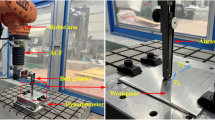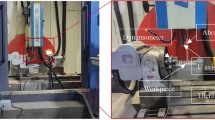Abstract
Glass fiber reinforced plastics (GFRP) are widely used in the design of rocket fairing and wind turbine blades due to their attractive advantages, such as lightweight, high strength and hardness, and high-temperature resistance. Its surface integrity characteristics, including surface roughness and surface morphology, influence the aerodynamic performance significantly. Belt grinding has been introduced into GFRP machining as a novel method. However, the adhesion wear of the abrasive belt usually happens during processing. However, its effects on the surface have not been investigated. In this paper, the adhesion characteristics of GFRP in belt grinding were experimentally explored to illustrate the correlation between adhesion wear and grinding parameters. The influences of different adhesion conditions on surface roughness and morphology were then explored. The surface roughness of GFRP decreased with the increase in the adhesion degree of the belt. In terms of both surface quality and processing cost, adhesion wear was acceptable to some degree. When the adhesion degree was between 20 and 24%, the surface quality of ground GFRP was acceptable.











Similar content being viewed by others
References
Guo GJ, Kethineni C (2020) Direct injection molding of hybrid polypropylene/wood-fiber composites reinforced with glass fiber and carbon fiber. Int J Adv Manuf Technol 106(1-2):201–209
Solati A, Hamedi M, Safarabadi M (2019) Comprehensive investigation of surface quality and mechanical properties in CO2 laser drilling of GFRP composites. Int J Adv Manuf Technol 102(1-4):791–808
Palanikumar K, Latha B, Senthilkumar VS, Paulo DJ (2013) Application of artificial neural network for the prediction of surface roughness in drilling GFRP composites. Mater Sci Forum 766:21–36
Ming IWM, Azmi AI, Chuan LC, Mansor AF (2018) Experimental study and empirical analyses of abrasive waterjet machining for hybrid carbon/glass fiber-reinforced composites for improved surface quality. Int J Adv Manuf Technol 95(9-12):3809–3822
Prasanth ISNVR, Ravishankar DV, Hussain MM, Badiganti CM, Sharma VK (2018) Investigations on performance characteristics of GFRP composites in milling. Int J Adv Manuf Technol 99(5-8):1351–1360
Ibraheem HMA, Iqbal A, Hashemipour M (2015) Numerical optimization of hole making in GFRP composite using abrasive water jet machining process. J Chin Inst Eng 38(1):66–76
Mohammad B, Ali T, Saeid A, Ahmad RG (2019) Parametric analysis of delamination in GFRP composite profiles by performing rotary ultrasonic drilling approach: experimental and statistical study. Compos Part B-Eng 172:612–620
Zhang XB, Wei XL (2007) Research on tool wear for FRP turning. Fiber Compos 24(3):27–28
Zhang QL (2009) Study on turning angle of glass fiber reinforced plastic materials. Mech Eng 8:136–137
Shyha I (2013) an investigation into CO2 laser trimming of CFRP and GFRP composites. Proc Eng 63:931–937
Zhang WS (1995) A brief discussion on the processing of GFRP. Fiber Reinforced Plastics/Compos 1:45–47
Song CM, Wang YF (2010) The research of grinding processing for GFRP. Mech Eng 5:43–47
Rodriguez RL, Lopes JC, Mancini SD, Sanchez LEDA, Varasquim FMFDA, Volpato RS, Mello HJD, Aguiar PRD, Bianchi EC (2019) Contribution for minimization the usage of cutting fluids in CFRP grinding. Int J Adv Manuf Technol 103(1-4):487–497
Lopes JC, Ventura CEH, Fernandes LDM, Tavares AB, Sanchez LEA, Mello HJD, Aguiar PRD, Bianchi EC (2019) Application of a wheel cleaning system during grinding of alumina with minimum quantity lubrication. Int J Adv Manuf Technol 102(1-4):333–341
Matthewson MJ, Gorham DA (1981) An investigation of the liquid impact properties of a GFRP radome material. J Mater Sci 16(6):1616–1626
Huang Y, He S, Xiao GJ, Li W, Jiahua SL, Wang WX (2020) Effects research on theoretical-modelling based suppression of the contact flutter in blisk belt grinding. J Manuf Process 54:309–317
Huang Y, Jiahua SL, Xiao GJ, He Y, Dai WT, He S, Li W (2020) Study on the surface topography of the vibration-assisted belt grinding of the pump gear. Int J Adv Manuf 106(1-2):719–729
Xiao GJ, Huang Y (2019) Micro-stiffener surface characteristics with belt polishing processing for titanium alloys. Int J Adv Manuf 100(1-4):349–359
Chu KF, Wei XX, Zhai YB (2005) Fiber dust collection and purification of FRP edge grinding. Environ Sci Technol 28(2):74–75
Xu Z (2000) Grinding of glass fiber reinforced plastics. Fiber Compos 17(02):28–29
Huang Y, Liu RJ, Huang Z (2010) Experimental analysis of abrasive belt grinding of GFRP composites. J Chongqing Univ 33(09):19–23
Zheng S, Huang Y, Yi H, Lu Y (2015) Grinding glass reinforced plastics with constant pressure in CBN abrasive belt. Mech Design Res 31(06):90–93
Niu SX, Niu BD, Gao WM (2014) High speed grinding of arc groove of FRP drum. Fiber Compos 1:13–18
Funding
This work was supported by National Natural Science Foundation of China (Grant No. U1908232) and the National Science and Technology Major Project (Grant No. 2017-VII-0002-0095).
Author information
Authors and Affiliations
Corresponding author
Additional information
Publisher’s note
Springer Nature remains neutral with regard to jurisdictional claims in published maps and institutional affiliations.
Rights and permissions
About this article
Cite this article
Huang, Y., Liu, S., Xiao, G. et al. Experimental investigation into the effects of adhesion wear on belt grinding of glass fiber reinforced plastics. Int J Adv Manuf Technol 109, 463–473 (2020). https://doi.org/10.1007/s00170-020-05610-5
Received:
Accepted:
Published:
Issue Date:
DOI: https://doi.org/10.1007/s00170-020-05610-5




